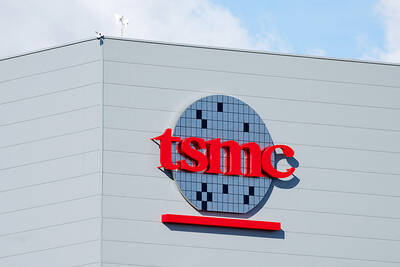Advantest Corp, one of the world’s major chip tester suppliers, yesterday said that the chip testing equipment market could regain growth this year, driven by rising demand for advanced testing services for artificial intelligence (AI) and high-performance-computing systems-on-chips and memory chips.
The frenzy of interest in ChatGPT and other AI-training applications has caused a surge in AI chip demand, but AI chip shipments have lagged due to supply constraints on advanced packaging capacity, Advantest Taiwan Inc chairman Alex Wu (吳萬錕) told reporters on the sidelines of the company’s annual media gathering in Taipei yesterday.
As the supply of advanced packaging capacity is set to improve this year, the volume of chips used in AI training systems and servers is also to increase, leading to growing demand for chip testing services and testing gear, Wu said.

Photo: Grace Hung, Taipei Times
Taiwan Semiconductor Manufacturing Co (TSMC, 台積電) said in October last year that it would more than double its advanced packaging or chip-on-wafer-on-substrate technology capacity this year compared with 2023, with the aim of catching up with high demand from customers such as Nvidia Corp.
Growing AI use is pushing the limits of chip complexity and advanced packaging, boosting testing time and the demand for chip testers to guarantee performance and quality, Wu said.
“We are looking at growth this year for the global testing equipment market, in line with the projections of most market analysts,” Wu said.
The global chip-testing tool market is set to return to an annual expansion of 17 percent this year, or US$8.1 billion, Advantest said, citing TechInsights Inc’s projection.
The market was estimated to shrink 15.8 percent year-on-year to US$6.9 billion, TechInsights said.
Growth would also be fueled by rapidly growing demand for high-bandwidth memory like DDR5 DRAM chips to support bigger data storage for AI inferencing, boosting testing services for such high-density and high-speed memory chips, Advantest said.
Additionally, Advantest is to benefit from the world’s race to build domestic chip supplies, it said. Since TSMC is expanding capacity overseas to Japan, the US and Europe, the chipmaker is likely to build more in-house chip testing capacity in Japan or Taiwan when the chip production scale expands, the company said.
Geographically, Asia remains the most active market, Wu said.
China has outpaced Taiwan and become the biggest market for Advantest since the second quarter of the company’s 2023 fiscal year. China accounted for 33 percent of the company’s revenue during the quarter, while Taiwan made up 16 percent, the company said.
Demand from China is huge, given that a large number of new chip manufacturing and outsourced semiconductor-assembly-and-test plants are scheduled to start operation in the following years, even though those chipmakers are concentrating on expanding mature chip technologies, rather than cutting-edge technologies, Wu said.
Advantest is following US chip export controls. The Tokyo-based testing equipment maker had a more than 50 percent share of the world chip testing equipment market.

Taiwan Semiconductor Manufacturing Co (TSMC, 台積電) secured a record 70.2 percent share of the global foundry business in the second quarter, up from 67.6 percent the previous quarter, and continued widening its lead over second-placed Samsung Electronics Co, TrendForce Corp (集邦科技) said on Monday. TSMC posted US$30.24 billion in sales in the April-to-June period, up 18.5 percent from the previous quarter, driven by major smartphone customers entering their ramp-up cycle and robust demand for artificial intelligence chips, laptops and PCs, which boosted wafer shipments and average selling prices, TrendForce said in a report. Samsung’s sales also grew in the second quarter, up

LIMITED IMPACT: Investor confidence was likely sustained by its relatively small exposure to the Chinese market, as only less advanced chips are made in Nanjing Taiwan Semiconductor Manufacturing Co (TSMC, 台積電) saw its stock price close steady yesterday in a sign that the loss of the validated end user (VEU) status for its Nanjing, China, fab should have a mild impact on the world’s biggest contract chipmaker financially and technologically. Media reports about the waiver loss sent TSMC down 1.29 percent during the early trading session yesterday, but the stock soon regained strength and ended at NT$1,160, unchanged from Tuesday. Investors’ confidence in TSMC was likely built on its relatively small exposure to the Chinese market, as Chinese customers contributed about 9 percent to TSMC’s revenue last

With this year’s Semicon Taiwan trade show set to kick off on Wednesday, market attention has turned to the mass production of advanced packaging technologies and capacity expansion in Taiwan and the US. With traditional scaling reaching physical limits, heterogeneous integration and packaging technologies have emerged as key solutions. Surging demand for artificial intelligence (AI), high-performance computing (HPC) and high-bandwidth memory (HBM) chips has put technologies such as chip-on-wafer-on-substrate (CoWoS), integrated fan-out (InFO), system on integrated chips (SoIC), 3D IC and fan-out panel-level packaging (FOPLP) at the center of semiconductor innovation, making them a major focus at this year’s trade show, according

DEBUT: The trade show is to feature 17 national pavilions, a new high for the event, including from Canada, Costa Rica, Lithuania, Sweden and Vietnam for the first time The Semicon Taiwan trade show, which opens on Wednesday, is expected to see a new high in the number of exhibitors and visitors from around the world, said its organizer, SEMI, which has described the annual event as the “Olympics of the semiconductor industry.” SEMI, which represents companies in the electronics manufacturing and design supply chain, and touts the annual exhibition as the most influential semiconductor trade show in the world, said more than 1,200 enterprises from 56 countries are to showcase their innovations across more than 4,100 booths, and that the event could attract 100,000 visitors. This year’s event features 17